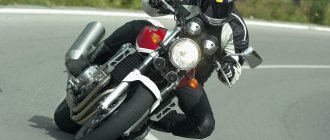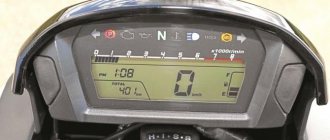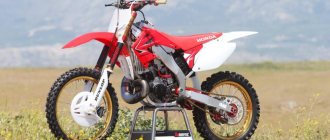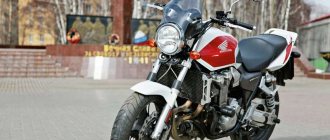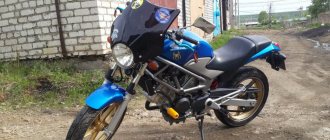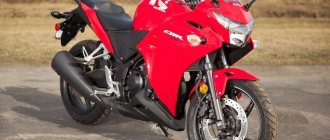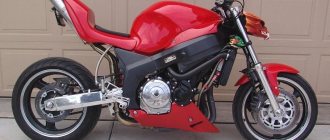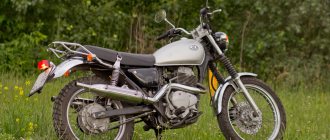| Honda CBX750F (1983) | Honda CBX750 Horizon (1984) | Honda CBX750F Bold'Or (1985) |
Honda CBX750F sports tourer model
appeared in December 1983 on the Japanese domestic market. Subsequently, the model was exported, sold mainly on the market of European countries. Some models were also supplied to North America (for the USA, due to customs restrictions, a version with an engine capacity reduced to 700 cm³ was supplied). Full-power export versions differed from domestic Japanese ones in higher engine performance (91 hp versus 77 hp). In all other respects these were almost identical models. A police version of the CBX750 was also offered for export markets.
In 1984, Honda expanded the CBX750 line by offering a new touring modification - the Honda CBX750 Horizon.
. The model was distinguished by wheels, a rectangular headlight with a small windshield, a cardan drive (instead of a chain), a drum rear brake (instead of a disc), a fuel tank of a different shape (reduced capacity from 22 to 16 liters), a rear suspension without progression, with two shock absorbers. The modification also received an LCD gear indicator, an oil cooler and a classic steering wheel (instead of a clip-on).
In 1985, a limited edition Honda CBX750F Bold'Or
, built on the basis of the regular CBX750F, which received a full plastic body kit, a new dashboard and changes in dimensions and ergonomics. The same year was the last year of production of the model.
A total of 12,000 motorcycles were produced (8,000 - CBX750F, 2,000 - Horizon, 2,000 - Bold'Or).
The main competitors of the Honda CBX750 in the class:
- Kawasaki GPZ750F/GPZ750R/GT750
Specifications
Technical characteristics of Honda CBX750:
| Model | Honda CBX750 |
| Motorcycle type | sports tourist |
| Year of issue | 1983-1985 |
| Frame | steel duplex |
| engine's type | 4-cylinder, 4-stroke, in-line |
| Working volume | 747 cm³ |
| Bore/Stroke | 67.0 x 53.0 mm |
| Compression ratio | 9,3:1 |
| Cooling | air |
| Number of valves per cylinder | DOHC chain drive, 4 valves per cylinder (with hydraulic lash adjusters) |
| Fuel supply system | Carburetor, 4x Keihin 34mm |
| Ignition type | fully transistorized |
| Maximum power | 77.0 hp (56.6 kW) at 9500 rpm - domestic versions 91.0 hp. (67.0 kW) at 9500 rpm - full-power export versions |
| Maximum torque | 65.0 Nm (6.6 kg*m) at 7500 rpm - domestic versions 70.0 Nm (7.1 kg*m) at 8500 rpm - full-power export versions |
| Clutch | Multi-disc in oil bath, hydraulic drive |
| Transmission | 6-speed |
| type of drive | chain – CBX750F, Bold'Or cardan – Horizon |
| Front tire size | 110/90-16 (59H) – CBX750F, Bold'Or 110/90-18 (61H) – Horizon |
| Rear tire size | 130/80-18 (66H) – CBX750F, Bold'Or 130/90-16 (67H) – Horizon |
| Front brakes | 2 discs, 2 piston calipers |
| Rear brakes | 1 disc, 2 piston caliper – CBX750F, Bold'Or Drum – Horizon |
| Front suspension | 38 mm telescopic fork with pumping and anti-dive (TRAC), travel - 150 mm |
| Rear suspension | Pro-Link pendulum with monoshock absorber – CBX750F, Bold'Or Pendulum with two shock absorbers (4-step rebound adjustment) – Horizon |
| Motorcycle length | 2145 mm – CBX750F, Bold'Or 2200 mm – Horizon |
| Motorcycle width | 740 mm – CBX750F 780 mm – Horizon 735 mm – Bold'Or |
| Motorcycle height | 1240 mm – CBX750F 1195 mm – Horizon 1285 mm – Bold'Or |
| Wheelbase | 1465 mm – CBX750F, Bold'Or 1515 mm – Horizon |
| Seat height | 795 mm – CBX750F 780 mm – Horizon 800 mm – Bold'Or |
| Minimum ground clearance (clearance) | 145 mm – CBX750F, Bold'Or 140 mm – Horizon |
| Acceleration 0-100 km/h (0-60 mph) | 4.3 sec[1] |
| Maximum speed | 211 km/h[2] |
| Gas tank capacity | 22.0 l (including reserve - 4.0 l) – CBX750F, Bold'Or 16.0 l – Horizon |
| Motorcycle weight (dry) | 217 kg – CBX750F 215 kg – Horizon 225 kg – Bold'Or |
| Motorcycle weight (curb) | 238 kg – CBX750F 231 kg – Horizon 247 kg – Bold'Or |
Honda CBX 750
The original Honda CB750 is one of the most significant models of the last century. Its influence is such that many call this model the “standard motorcycle” - the ultimate classic. For more than ten years it was the pride of the Honda model range, and its smaller relatives did well in the shadow of this titanium. So when Honda announced plans to release not one, but two sportbikes, they were eagerly awaited and with very high expectations. And then they appeared - the Honda VF750 with “chocolate camshafts” that crumbled like hard cheese, and the Honda CBX - too square even for the square eighties, and remained misunderstood and underestimated in its era.
Honda CBX 750
But when a customer drove a 1986 Honda CBX 750 into the AMP workshop, father and son Mikael and Allen Posenauer immediately saw its potential! A torquey engine, easy maintenance thanks to self-adjusting valves, very good suspension and brakes compared to a regular Honda CB, a narrow engine that allows you to lean even lower than the tires allow, and the weight distribution does not try to fold the motorcycle under the rider. So, after listening to brief wishes from the owner, the family disassembled the 1986 Honda CBX 750 and began to sketch out options on how to present it in the best possible way, without turning it into something unclear.
Review of CB 750 seven fifty
Now the time has come to sum up the results of riding on this wonderful machine...
During the time that I rode it, I managed to get to know it quite well. The motorcycle is very good for its purposes, but as it turns out, we have different manners. I decided to find a new rider for this horse. We didn’t have to wait long; after warming it up, starting it up and showing it was in excellent condition, the new owner took it to a new home.
All that was left was money and impressions. The last one I will share 
After the itch, due to the high center of gravity, this motorcycle seemed unrealistically heavy in place. Once I even collapsed in the parking lot, unexpectedly, I didn’t even have time to do anything! It’s also not very convenient to maneuver at low speeds; the risk of falling over is also very high. Because of this, he feels good and confident on the track. From the mountain, up the mountain, alone, or together with a load - it doesn’t matter to him. The wide seat and rubberized feet for the passenger seem to indicate that this motorcycle is a cruiser type. I was also pleased with the gas mileage on the highway; it turned out to be the same as that of the four hundred. On a small long-distance trip with scabies, without stopping for gas, they added approximately equal amounts of gasoline to the tank, which is understandable; there is no need to unscrew the accelerator handle here.
Separately about the tires. Unlike the previous motorcycle, this one had Michelin. Friends, don’t buy cheap tires, only after feeling the quality of the brand’s grip did I understand how important it is.
About the dynamics in the city. This is where the main failure was. I drive 80% in the city and here our characters did not agree. No, it can move between rows and confidently accelerate without problems, but...
The engine shows its potential already at 4-5 thousand revolutions; coupled with a five-speed gearbox, it completely deprives it of its sporty character. Driving with an engine that hasn't been revved up is downright boring; it doesn't add any gyroscopic forces, which again affects handling at low speeds. Flimsy brakes for this weight also do not add confidence to driving. The front fork is a copy of the 400, it is weak there, but here it is clearly expressed. A slightly more viscous fork oil corrects the situation a little.
Bottom line. The motorcycle is generally good, reliable with a soft gearbox. More suitable for lovers of short long-distance trips and country trips and sometimes when necessary to travel around the city. Reliable, powerful, forgiving of pilot mistakes. Not suitable for those who are short (my height is 180 cm), thin and spend most of their time riding around the city.
Well, that seems to be all.
Attached videos:
Tags
- CB750
- Honda
- review
- review
Motorcycle Honda CB 750 Nighthawk 1996 review
Specifications Honda CB 750 Nighthawk 1996
Engine Honda CB 750 Nighthawk 1996
Transmission Honda CB 750 Nighthawk 1996
Dimensions and weights of Honda CB 750 Nighthawk 1996
Chassis and brakes Honda CB 750 Nighthawk 1996
Dynamic characteristics of Honda CB 750 Nighthawk 1996
Other characteristics of Honda CB 750 Nighthawk 1996
Description Honda CB 750 Nighthawk 1996
The description of the Honda CB 750 Nighthawk 1996 motorcycle is in the queue for publication of the article. Announcement: Today, for almost every new motorcycle that comes into being, marketers strive to carve out their own niche. This one is a road sport, this one is a recreational enduro. But what class should we include a motorcycle that has a little bit of everything? A good bike should have a reliable engine, comfortable ergonomics and simple controls.
Despite the fact that good models of motorcycles have a very respectable price, and the season for their use is relatively short, the motorcycle market is developing rapidly. And if you believe the words of dealers, then some models of recently released motorcycles are selling like hot cakes at the beginning of the season, and the models brought to Russia are clearly not enough to fully satisfy consumer demand.
A motorcycle has long ceased to be an alternative to a car, and the times when this equipment was bought only because there was not enough money for a full-fledged car are forgotten. Nowadays, two-wheelers can be called technological marvels in many cases, and their cost can be compared with that of prestigious cars.
Many people have started buying motorcycles for hobby purposes as riding or even collecting them has become a good pastime for many people. Many motorcycles, for example the Honda CB 750 Nighthawk, whose technical characteristics allow the model to be called a prestigious brand, are in demand among both beginners and experienced motorcyclists.
Currently, it is impossible to purchase a new Honda CB 750 Nighthawk motorcycle from the 1996 model year, since their production stopped 20 years ago. At the same time, the Honda CB 750 Nighthawk has excellent technical characteristics, so many are eager to purchase, if not a new, then at least a used version.
Motorcycles with an engine capacity of 747 cc / 45.5 cu-in. see, appeared as a result of long work of inventors who sought to create a model that was not inferior in characteristics to other versions of the motorcycle. In some cases, these models are not only not inferior, but also ahead of other motorcycles, as they have minimal fuel consumption and other excellent parameters.
Motorcycles with an engine capacity of more than 400 kb. cm, which includes the Honda CB 750 Nighthawk - this category of motorcycles simply cannot claim the title of “motorcycle for a beginner.” On the contrary, this is already a serious technique that requires certain control of motorcycle equipment with a smaller engine capacity. Yes, she attracts more attention, she is the most beautiful, fast, interesting and there is a huge selection of models. But as power increases, the weight of the motorcycle inevitably increases. In this class you are unlikely to find motorcycles lighter than 180 kg, unless they are the latest motorcycle models.
Go to the entire range of Honda motorcycles, on this page you can find Honda CB 750 Nighthawk motorcycles from other years of production and information about them
Motorcycles similar in characteristics to the CB 750 Nighthawk:
Showing similar motorcycles with a limit of 5 pieces, see all similar to CB 750 Nighthawk
Price of Honda CB 750 Nighthawk according to advertisements for sale
* Attention! Under the maximum, average and minimum of the Honda CB 750 Nighthawk motorcycle on this page, the average cost according to advertisements for sale on the Internet is indicated, without taking into account the year of manufacture, configuration and generation of the motorcycle model.
Five random motorcycles:
Five random articles about motorcycles:
Java 680 Trial (250 cc)
Jawa-680 250 cc for trial Among fans of motorcycle sports, there are more and more people who are fond of trials. Accordingly, the share of trial machines in the global production of sports motorcycles is growing. Now they are made by such factories as the Italian "Aprilia", "Beta", "Garelli", the Japanese "Honda", "Simson" - in the GDR, ChZ and JAVA - in Czechoslovakia. One of the largest manufacturers of sports motorcycles, Italian, annually produces 5,000 machines specially designed for such competitions. On the scale of Western Europe, this is a rather impressive figure. YAVA-680 is a special motorcycle of the 1987 model. The engine with a displacement of 246 cm3 with a cylinder diameter of 70 mm and a piston stroke of 64 mm is a further modification of the YAVA-125 engine. When creating it, the goal was to ensure minimal external dimensions and weight. The cylinder is made of an alloy of light metals, a mixture of r.
How to increase the durability of the IZHRP-1S turn relay on IZH Planet 3 and Jupiter 3 motorcycles
IZHRP-1S relay On the IZH-Planet-3 and IZH-Jupiter-3 motorcycles, the IZHRP-1S turn signal relay is constantly turned on simultaneously with the ignition. To make it work only when using turn indicators, some motorcyclists modify the switches, as described in the magazine “Behind the Wheel.” Motorcyclists who are familiar with the basics of electrical and radio engineering can achieve the same goal by slightly modifying the relay. It is enough to introduce two diodes of type D208 (or D7) into the circuit and change the switching circuits, as shown in the figure. The relay converted in this way has been working flawlessly for three years.B. ROGOZHIN141300, Moscow region, Zagorsk, 4, apt. 4 Diagram of the converted relay IZHRP-1S (changes are highlighted in bold lines). 1976N06P37
Installation of the electronic ignition system unit Electronics on the Dnepr MT-10 motorcycle
The Electronics ignition system electronic unit, designed for cars, works successfully on the Dnepr MT-10 motorcycle, which has 12-volt electrical equipment. Of these devices, it is the cheapest, small-sized, has an outlet and serves as an anti-theft device. I installed it in the luggage compartment of the stroller and connected it as follows. Terminal lug No. 7 is connected to the “LK” terminal of the relay-regulator, which increased the secondary voltage when starting the engine, and terminal lug No. 9 is connected to ground. Four wires collected in a bundle were connected (see figure). The capacitor was disconnected. The engine starts easily even in winter, the breaker contacts practically do not wear out, and the gap between them does not require adjustment. V. DONETSKrasnodar region, Khatukai village Connecting the unit cable: 1— cable; 2— wire from the ignition switch (+ 12 V); 3— ignition coil B204; 4 - breaker. In circles &.
Electrical diagram of Dnepr MT-10
Rice. 1 — left turn signal light 2 — lamp A12-21; 3 - headlight; - 4 - lamp A12-4 side and parking light; 5 — lamp A12-45-40 high and low beam; 6 — right turn signal lamp (not connected on a motorcycle with a sidecar): 7 — speedometer; 8 — lamp A12-1 speedometer lighting; 9 — indicator lamp for direction indicators; 10 — warning lamp for emergency oil pressure; 11 — high beam warning lamp; 12 — generator warning lamp; 13 — neutral sensor warning lamp; 14 — instrument panel; 15 - central switch; 16 — direction indicator switch; 17 – turn signal switch; 18 — contact plug; 19 — emergency oil pressure sensor; 20 - light switch; 21 — front light of the stroller 22 — lamp A12-21 for side light and brake signal on the stroller; 23 - bl.
Dnepr MT-10-36
Modernized motorcycle Dnepr Motorcycle "Dnepr" MT10 -36. Externally, it can be distinguished from previous models by levers with balls at the ends, union nuts on the exhaust pipes, and a passenger footrest that folds up and back. Last year, 1976, the Kiev motorcycle plant carried out a serious modernization of the Dnepr MT10 motorcycle it produced. First, the engine power was increased - from 32 to 36 hp. With. (see “Behind the Wheel”, 1976, No. 10), and then some components of the crew part were changed. This is a stage of a broad program to improve and improve the quality of motorcycle manufacturing, planned for the current five-year period. The modernized model received the designation MT10-36. The main directions of the work carried out were determined by the requirements of new, more stringent GOSTs in terms of increasing the active and passive safety of the motorcycle and reducing external noise. Rice. 1. Two-cam brake of the front wheel: 1 - driven lever; 2.
